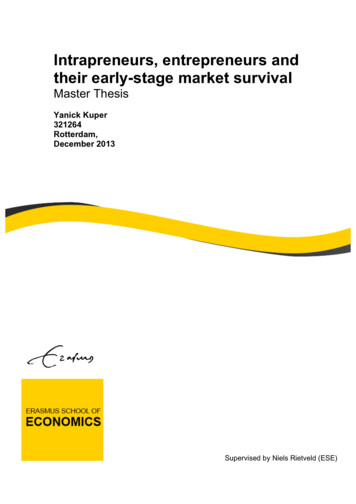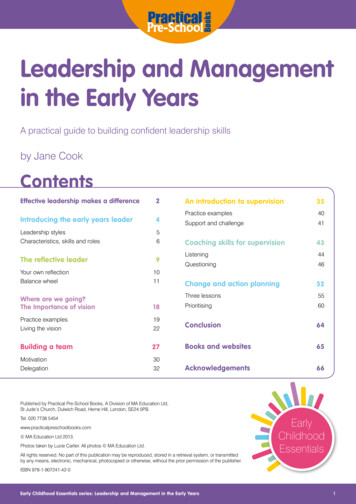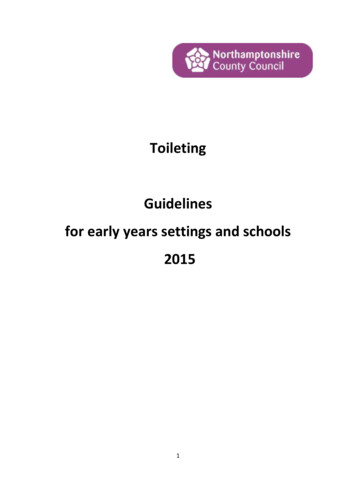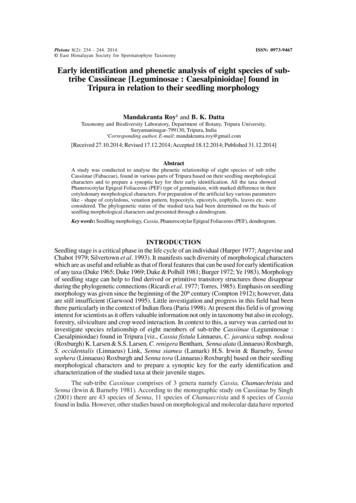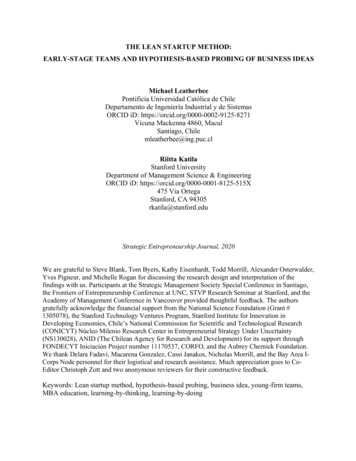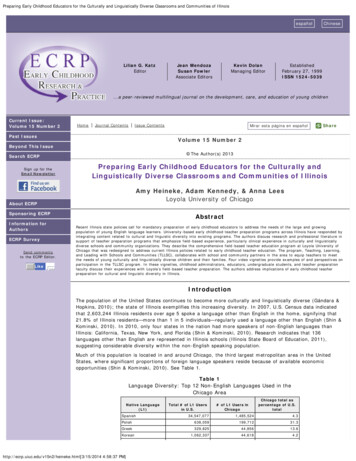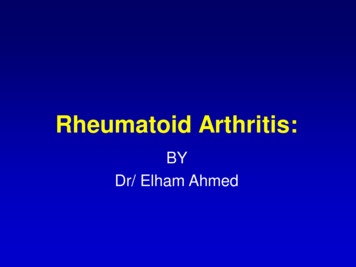
Transcription
Art and art in Early Childhood:What Can Young Children Learnfrom “a/Art activities?”Anna M. KindlerUniversity of British Columbia, CanadaJustifying art activities in early childhood education seems like a trivial task. Everyoneknows that young children love to draw, dip their fingers in paint or squeeze playdoughto create images and forms that only those with hardened hearts would find difficultto appreciate. Children seem happier when they have access to art materials andsupplies than when they are denied such opportunities, and usually they do not needmuch invitation to spontaneously take advantage of these offerings. The outcomesof children’s “art play” tend to fascinate adult audiences – and adults: from artisticallynaïve parents, through psychologists and therapists, to researchers specifically studyingartistic development – have long attempted to understand their significance andmeaning. Early childhood classrooms are cheerful and require minimal budgets todecorate with the abundance of children’s art. Early childhood parents and teachersalso trust, or at least hope, that there are some significant formative benefits to childrenfrom their engagement in art activities, such as development of creativity.On the intuitive level, there is significant merit in setting up art centres in preschoolclassrooms and allowing children to play with art materials. There is somethinggood about it. If one is willing to accept, and most early childhood educators todaydo, that learning through play is one of the most effective strategies in educatingyoung children– than art activities, with all the spontaneous attention that they draw,enjoyment that they generate and facility with which they can be implemented in earlychildhood settings seem strongly justified as a core element in ECE practice. Yet, somequestions can, and perhaps should be asked: What exactly are the children learning,and how do the organization and design of specific activities and the teacher’s rolecontribute to the achievement of worthwhile educational outcomes?Figure 11 - International Art in Early Childhood Research Journal, Volume 2, Number 1. 2010.
I believe that art educators have not always been very clear nor persuasive in theiranswers to these questions. Broad references to “artistic learning” have frequentlybeen thin on defining the essence of such learning while taking it for granted thatactivities that involve children manipulating materials similar to those that artists havehistorically used and exploring pictorial means for the purposes of representation, havesomething to do with this process. It has also often been assumed that these forms ofengagement contribute to some broader gains transferable to other domains of humanendeavor. In the Spring of 2006, I attended a UNESCO conference in Portugal focusedon the benefits of the arts, and I have left this event with an uncomfortable feeling. Onthe one hand, I was very inspired by the energy, commitment and sense of convictionby the advocates of the arts, but on the other, I remained seriously unconvinced thatart (or even the arts) were indeed the answer to all the world’s ills, as some of thepresenters suggested. I was struck by the level of generality in the discourse and thelack of attention to the details that could, in my view, build a much stronger rationalefor the arts - and - even more importantly, help teachers and parents focus their effortsand resources on what could lead to the achievement of most worthwhile and realisticgoals.Although a number of scholars have attempted to articulate more clearly both thenature and the benefits of learning in and through art (e.g., Eisner, 2002), it seems thatamong art education practitioners the emphasis has often rested on rather lofty butbroad assumptions. In this paper, I will try to challenge some of the long standingclaims about the overall “goodness” and relevance of art in education – not to argueagainst the engagement of young children in “art” activities but rather to seek clarityon what we are (or may be) trying to achieve in early childhood art education as weattempt to cater to the developmental needs of a child in a domain that is concernedwith the visual and with the ever-evolving concept of human artistry.The confusion, stemming from its casual use, about the meaning of the term “art”(atleast in the English speaking world) – from a discipline as defined by its experts, toany, even most naïve, forms of human engagement with the visual – has made it verydifficult to define artistic development in any meaningful ways.If one understands art as a field of serious professional creative activity, which is asubject to review and assessment by those who posses the relevant expertise andexperience to make such determinations – then the idea of artistic development hasto be related to the attributes and features which characterize artistic production ofrecognized artists and the expectations of the “custodians” of the artistic domain. If oneunderstands art as any form of human pictorial activity – than the definition of artisticdevelopment becomes both impossible and unnecessary in the absence of any criteriathat would allow to define a direction (or directions) of progress. Somewhere betweenthe two extremes , these is a possibility of defining art as those forms of pictorialactivity that conform to some broad criteria of quality – with the notion of artisticdevelopment tied to the development in the ability to create pictures that demonstrateprogress along these selected dimensions. Needless to say, the community of artcritics, art historians, museum and gallery curators subscribe to the former definition.I would argue that in art education, we have moved increasingly closer to adoptingthe latter – which has seriously complicated our ability to be explicit and clear about2 - International Art in Early Childhood Research Journal, Volume 2, Number 1. 2010.
our goals and achievements. Early in my graduate education I remember taking acourse with Kenneth Lansing – a student of Victor Lowenfeld – who insisted on theimportance of art teachers having a clear understanding of what art is and whatdistinguishes it from other human endeavors. He was not suggesting that all artteachers should adopt a single particular stance, nor had advocated the need for aclosed definition of art – but rather argued that in the absence of an understanding ofwhat some of the crucial attributes of the concept are, it is impossible to meaningfullyengage in the teaching of art. Some twenty years later, examining this issue from theperspective of my practice and research in art education, I am persuaded more thanever of the value of Lansing’s teaching.I should preface this paper by clearly stating, that especially in the contemporarycontexts where visual imagery other than “recognized” art has become so prevailing,so influential and so seductive in the lives of even very young children, I fully supportand encourage early childhood contribution to the development of broadly definedchildren’s representational competencies, including those that make use of graphicrepertoires. My focus in this paper on artistic development does not suggest my lackof interest in children’s learning about visual culture and developing abilities to be itsintelligent consumers. I believe, however, that artistic learning is still of great valueand importance in early childhood – yet, this specific focus has largely slipped theattention of curriculum makers and teachers – due, at least to some extent, to the lackof conceptual clarity about want exactly we want to nurture and develop through ourinvolvement in the educational process.My paper, therefore, consists of two parts. Firstly, I attempt to define the concept ofartistic development in a close relationship to the world of “acclaimed art.” I thus tryto provide a framework for the understanding key factors that contribute to artisticdevelopment and then use this framework to consider educational implications.Secondly, with the concept of artistic development operationally defined, I suggestsome dimensions of artistic growth that can, and - in my view - should be nurturedin early childhood art education and point to the ways in which such development isrelevant to much broader than only “artistic” contexts. By doing so, I hope to signal thatdeveloping artistically serves well not only those children destined for artistic futures,but also those who will be consumers of art, and more broadly, of visual culture.What is the meaning of “artistic development?A good starting point for this discussion would be to look at some theories that havebeen proposed to outline it. One of the most influential theories was proposed byVictor Lowenfeld’s (1934). It defines artistic development as a staged progressionfrom what Lowenfeld referred to as uncontrolled scribbles to forms of pictorialrepresentation which increasingly conform to the requirements of visual realism.Although it would be hard to argue with Lowenfeld’s observations that human pictorialproduction in early childhood years normally has visual attributes of random andundifferentiated marks and that there seems to be an inborn impulse towards formsof representation which allow to capture meaning in ways that can be socially shared(and visual realism is clearly a graphic convention that lands itself to this purpose) - thestage theory has a serious shortcoming in terms of its power to define development in3 - International Art in Early Childhood Research Journal, Volume 2, Number 1. 2010.
art.The key problem is that the world of art has long abandoned visual realism as alikely endpoint in the development of artistry. So while Lowenfeld’s theory tracks apossible progress along a specific trajectory in pictorial representation, it remainsdistant from the world of art and fails to account for development of artistic talentand competence of artists who are our contemporaries. It also focuses on twodimensional representation and, essentially, a graphic vocabulary, paying little attentionto any other attributes – such as quality of thought, for example, that arguably isnot inconsequential in artistic creativity. These limitations make Lowenfeld’s theorynot very useful for the purposes of helping us capture the complex nature of artisticdevelopment.Another influential theory proposed by Jessica Davis, Howard Gardner and EllenWinner (Davis, 1991, 1997a, 1997b; Gardner & Winner, 1982), has a much closer, explicitconnection to a specific movement in art. The U curve model posits that developmentof artistry does not proceed in a linear fashion nor that it involves improvement overtime. What these researchers observed, and Davis later demonstrated in a controlledexperiment is that artistic capacity of young children is superior to that of olderyouth and that the natural developmental pattern leads towards a demise rather thanimprovement in artistry, except in the cases of very selected, particularly talentedindividuals. In Davis’s experiment, the link between the U-curve theory and the worldof art has been asserted by the use of a set of criteria to determine the quality of artisticproduction that was assessed by expert judges based on Goodman’s aesthetic protocol(Goodman, 1968). This protocol very clearly reflected an aesthetic value systemcorresponding to the modernist artistic heritage. In this case, the alignment with aparticular artistic tradition constituted both an asset and a limitation. On the one hand,it brought the consideration of artistic development much more closely to the realm ofvalues and interests of the world of art, but on the other, by making this connection toa particular artistic framework it weakened the universality of the theory in the broadercontext of the changing world of art.Figure 24 - International Art in Early Childhood Research Journal, Volume 2, Number 1. 2010.
This consequence was well demonstrated in further studies conducted in crosscultural contexts (e.g., Kindler, 2001; Kindler, Liu, Pariser & van den Berg, 2003; Kindler,Pariser, van den Berg, Liu. 2002; Kindler, Pariser, van den Berg, Liu & Dias, 2002; Pariserand van den Berg, 1997) which revealed a range of “developmental” patterns througha sorting task that originated from Davis’ study. As shown here in the results from ourresearch project conducted in Taiwan, these patterns ranged from the U-curve to aninverted U, with a straight upward sloping line characterizing the majority of responses.Figure 3Repertoire theories of artistic development (e.g., Kindler, 1999; Kindler & Darras, 1994,1997, 1998; Wolf, 1994; Wolf and Perry, 1988) which suggest multiple rather than asingle path towards development in pictorial representation, while accounting fordevelopment in a much wider range of artistic realms (and thus being more robustfrom a cross-cultural perspective) have, by design, shone away from distinctionsbetween the artistic and the non-artistic imagery. Their focus has been on theunderstanding of pathways in the development of pictorial representation regardlessof its classification into the category of art. Such theories remain very useful to the fieldof art education – especially as it attempts to re-define itself and consider inclusionof a full spectrum of imagery that permeate visual culture of contemporary societies.However, they are deficient as theories of artistic development because of their broadfocus.In recent years, drawing on creativity research (e.g., Csikszenmihalyi, 1988, 1990, 1999),I have proposed an alternative theory of artistic development based on a systemsapproach (Kindler, 2003, 2004, 2006). This theory explicitly links development inpictorial representation at a level of an individual with changes that occur over timewithin the domain of art itself. It suggests that artistic development is a relational,dynamic concept, constantly in flux and constantly in the process of redefining. On theone hand, psy
1 - International Art in Early Childhood Research Journal, Volume 2, Number 1. 2010. Justifying art activities in early childhood education seems like a trivial task. Everyone knows that young children love to draw, dip their fingers in paint or squeeze playdough to create images and forms that only those with hardened hearts would find difficult to appreciate. Children seem happier when they .


